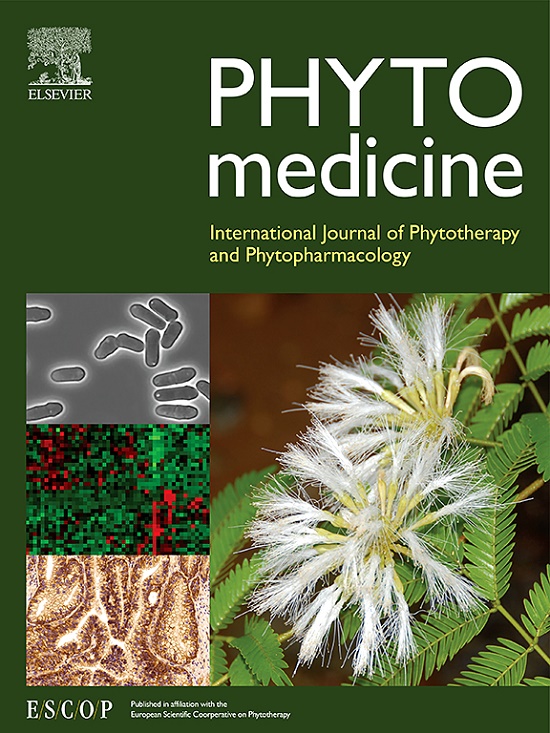Integrated network pharmacology and experimental validation to elucidate the mechanism of celastrol in mitigating sepsis-induced acute lung injury in mice
IF 6.7
1区 医学
Q1 CHEMISTRY, MEDICINAL
引用次数: 0
Abstract
Background
Sepsis is an acute, life-threatening condition that precipitates multiple organ failure, including acute lung injury (ALI), characterized by a complex pathophysiological process and elevated mortality rates. Celastrol, a pentacyclic triterpenoid quinone derived from traditional Chinese medicine, exhibits diverse pharmacological properties, including immunomodulatory, anti-inflammatory, anticancer, and antifibrotic effects, and has demonstrated favorable safety profiles in vivo. However, the precise mechanism by which CSL contributes to sepsis-induced ALI remains to be elucidated.
Purpose
The study aimed to explore the mechanisms by which celastrol mitigates sepsis-induced ALI using network pharmacology, followed by experimental validation of its regulatory effects on sepsis-induced ALI.
Methods
Utilizing a network pharmacology analysis, the potential targets and pathways of celastrol were identified. To explore celastrol's therapeutic effects on ALI, a rat model of sepsis was induced via cecal ligation and puncture, followed by assessment through hematoxylin-eosin staining, Real-time quantitative polymerase chain reaction (RT-qPCR), and Western blotting. Further investigation involved evaluating celastrol's influence on LPS-stimulated A549 and Raw264.7 cells, employing RT-qPCR, Western blotting, and immunofluorescence techniques.
Results
Network pharmacological analysis identified 10 core targets and 31 pathways relevant to sepsis-induced ALI, with STAT3, TLR4, HIF-1α, and NF-κB1 emerging as central targets. Animal experiments demonstrated that celastrol treatment significantly reduced lung tissue inflammation, as evidenced by immunohistochemistry, Western blot, and RT-qPCR results, in comparison to the cecal ligation and puncture group. Notably, the levels of IL-1β, TNF-α, HIF-1α, STAT3, and NF-κB1 proteins and mRNA in the celastrol treatment group were significantly reduced compared to those in the cecal ligation and puncture (CLP) group and the LPS-treated group. Additionally, Western blot and immunofluorescence analyses confirmed the activation of the NF-κB pathway in vitro.
Conclusion
This study indicates that celastrol significantly suppresses the expression of inflammatory factors in sepsis-induced ALI by inhibiting the NF-κB/HIF-1α pathway in both in vivo and in vitro models, highlighting its therapeutic potential for modulating inflammation. These findings provide valuable evidence for future clinical research and drug development.

综合网络药理学和实验验证阐明雷公藤红素减轻脓毒症致小鼠急性肺损伤的机制
脓毒症是一种急性、危及生命的疾病,可导致包括急性肺损伤(ALI)在内的多器官衰竭,其特点是复杂的病理生理过程和死亡率升高。雷公藤红素是一种源自传统中药的五环三萜醌,具有多种药理特性,包括免疫调节、抗炎、抗癌和抗纤维化作用,并且在体内已被证明具有良好的安全性。然而,CSL促进败血症诱导ALI的确切机制仍有待阐明。目的利用网络药理学方法探讨雷公藤红素减轻脓毒症ALI的机制,并通过实验验证其对脓毒症ALI的调节作用。方法采用网络药理学分析方法,确定雷公藤红素的潜在作用靶点和作用途径。为探讨celastrol对ALI的治疗作用,采用盲肠结扎穿刺诱导脓毒症大鼠模型,苏木精-伊红染色、实时定量聚合酶链反应(RT-qPCR)和Western blotting进行评价。进一步的研究包括利用RT-qPCR、Western blotting和免疫荧光技术评估celastrol对lps刺激的A549和Raw264.7细胞的影响。结果网络药理学分析确定了10个核心靶点和31条与败血症诱导ALI相关的通路,其中STAT3、TLR4、HIF-1α和NF-κB1是中心靶点。动物实验表明,免疫组织化学、Western blot和RT-qPCR结果表明,与盲肠结扎和穿刺组相比,celastrol处理显著减轻了肺组织炎症。值得注意的是,与盲肠结扎穿刺(CLP)组和脂多糖治疗组相比,雷公芪红素治疗组IL-1β、TNF-α、HIF-1α、STAT3、NF-κB1蛋白和mRNA水平显著降低。此外,Western blot和免疫荧光分析证实NF-κB通路在体外活化。结论在体内和体外模型中,雷公藤红素均通过抑制NF-κB/HIF-1α通路,显著抑制脓毒症ALI中炎症因子的表达,显示其调节炎症的治疗潜力。这些发现为今后的临床研究和药物开发提供了有价值的依据。
本文章由计算机程序翻译,如有差异,请以英文原文为准。
求助全文
约1分钟内获得全文
求助全文
来源期刊

Phytomedicine
医学-药学
CiteScore
10.30
自引率
5.10%
发文量
670
审稿时长
91 days
期刊介绍:
Phytomedicine is a therapy-oriented journal that publishes innovative studies on the efficacy, safety, quality, and mechanisms of action of specified plant extracts, phytopharmaceuticals, and their isolated constituents. This includes clinical, pharmacological, pharmacokinetic, and toxicological studies of herbal medicinal products, preparations, and purified compounds with defined and consistent quality, ensuring reproducible pharmacological activity. Founded in 1994, Phytomedicine aims to focus and stimulate research in this field and establish internationally accepted scientific standards for pharmacological studies, proof of clinical efficacy, and safety of phytomedicines.
 求助内容:
求助内容: 应助结果提醒方式:
应助结果提醒方式:


